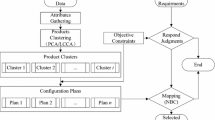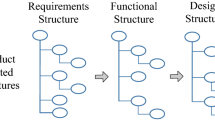Abstract
Product design is greatly influenced by product configuration processes and can be suspended or result in failure if the configuration process consumes too much time, cost, or resources; such results can also occur if the end products manufactured based on configurations failed to satisfy customers. Therefore, a configuration approach that saves time, cost, and resources, as well as highly satisfies customers, is necessary and significant. Against the background, this study proposes a configuration approach that uses online data to map customer requirements into product configurations, including the product transaction data and customer review data. The approach generates feasible configurations initially by using transaction data. Next, the approach produces training samples based on positive customer review data. Lastly, the intelligent classifier is trained by the training samples and is utilized to select final configurations from feasible configurations to satisfy customer requirements. A real-world design case of smartphones is used to illustrate the proposed approach, and the results indicate that this approach saves time, cost, and resources and is competitive compared with other product configuration methods. This novel configuration approach provides designers and companies with a superior and efficient method to complete configuration tasks with competiveness and low risk and adds value to the usability and analysis of online data.






Similar content being viewed by others
References
Aldanondo, M., & Vareilles, E. (2008). Configuration for mass customization: How to extend product configuration towards requirements and process configuration. Journal of Intelligent Manufacturing, 19(5), 521–535.
Andersen, H., Hadzic, T., & Pisinger, D. (2010). Interactive cost configuration over decision diagrams. Journal of Artificial Intelligence Research, 37, 99–139.
Arrighi, P. A., & Mougenot, C. (2016). Towards user empowerment in product design: A mixed reality tool for interactive virtual prototyping. Journal of Intelligent Manufacturing,. https://doi.org/10.1007/s10845-016-1276-0.
Barker, T. B., & Milivojevich, A. (2016). Quality by experimental design. Boca Raton, FL: CRC Press.
Cambria, E., Schuller, B., Xia, Y., & Havasi, C. (2013). New avenues in opinion mining and sentiment analysis. IEEE Intelligent Systems, 28(2), 15–21.
Carlgren, L. (2013). Identifying latent needs: Towards a competence perspective on attractive quality creation. Total Quality Management & Business Excellence, 24(11–12), 1347–1363.
Carlgren, L., Elmquist, M., & Rauth, I. (2014). Design thinking: Exploring values and effects from an innovation capability perspective. The Design Journal, 17(3), 403–423.
Carulli, M., Bordegoni, M., & Cugini, U. (2013). An approach for capturing the voice of the customer based on virtual prototyping. Journal of Intelligent Manufacturing, 24(5), 887–903.
Clemons, E. K., Gao, G., & Hitt, L. M. (2006). When online reviews meet hyperdifferentiation: A study of craft beer industry. Journal of Management Information Systems, 23(2), 149–171.
Decker, R., & Trusov, M. (2010). Estimating aggregate consumer preferences from online product reviews. International Journal of Research in Marketing, 27(4), 293–307.
der Ryn, S. V. (2013). Opportunities for empathic design. In S. V. der Ryn & F. Allen (Eds.), Design for an empathic world (pp. 101–120). Washington, D.C.: Island Press.
Dopico, J. R. R., Dorado, R., & Pazos, A. (2008). Encyclopedia of artificial intelligence. Hershey, PA: IGI Global.
Dou, R., Zhang, Y., & Nan, G. (2016a). Customer-oriented product collaborative customization based on design iteration for tablet personal computer configuration. Computers & Industrial Engineering, 99, 474–486.
Dou, R., Zong, C., & Li, M. (2016b). An interactive genetic algorithm with the interval arithmetic based on hesitation and its application to achieve customer collaborative product configuration design. Applied Soft Computing, 38, 384–394.
Dou, R., Zong, C., & Nan, G. (2016c). Multi-stage interactive genetic algorithm for collaborative product customization. Knowledge-Based Systems, 92, 43–54.
Dou, R., Zhang, Y., & Nan, G. (2017). Iterative product design through group opinion evolution. International Journal of Production Research, 55(13), 3886–3905.
Engler, T. H., Winter, P., & Schulz, M. (2015). Understanding online product ratings: A customer satisfaction model. Journal of Retailing and Consumer Services, 27, 113–120.
Fallman, D., & Stolterman, E. (2010). Establishing criteria of rigour and relevance in interaction design research. Digital Creativity, 21(4), 265–272.
Feldman, R. (2013). Techniques and applications for sentiment analysis. Communications of the ACM, 56(4), 82–89.
Fuchs, C., & Schreier, M. (2011). Customer empowerment in new product development. Journal of Product Innovation Management, 28(1), 17–32.
Haug, A., Hvam, L., & Mortensen, N. H. (2012). Definition and evaluation of product configurator development strategies. Computers in Industry, 63(5), 471–481. https://doi.org/10.1016/j.compind.2012.02.001.
Hienerth, C., Lettl, C., & Keinz, P. (2014). Synergies among producer firms, lead users, and user communities: The case of the Lego producer-user ecosystem. Journal of Product Innovation Management, 31(4), 848–866.
Hjort, K., Lantz, B., Ericsson, D., & Gattorna, J. (2013). Customer segmentation based on buying and returning behaviour. International Journal of Physical Distribution & Logistics Management, 43(10), 852–865.
Hsieh, M. H., Tsai, K. H., & Hultink, E. J. (2006). The relationships between resource configurations and launch strategies in Taiwan’s IC design industry: An exploratory study. Journal of Product Innovation Management, 23(3), 259–273.
Jannach, D., & Zanker, M. (2013). Modeling and solving distributed configuration problems: A CSP-based approach. IEEE Transactions on Knowledge and Data Engineering, 25(3), 603–618.
Jiao, Y., Yang, Y., & Zhang, H. (2017). An integration model for generating and selecting product configuration plans. Journal of Intelligent Manufacturing,. https://doi.org/10.1007/s10845-017-1324-4.
Jin, J., Ji, P., & Gu, R. (2016). Identifying comparative customer requirements from product online reviews for competitor analysis. Engineering Applications of Artificial Intelligence, 49, 61–73.
Kangale, A., Kumar, S. K., Naeem, M. A., Williams, M., & Tiwari, M. K. (2016). Mining consumer reviews to generate ratings of different product attributes while producing feature-based review-summary. International Journal of Systems Science, 47(13), 3272–3286.
Karkare, V. Y., & Gupta, S. R. (2013). A survey on product evaluation using opinion mining. International Journal of Computer Science and Applications, 6(2), 306–312.
Keogh, E., & Mueen, A. (2011). Curse of dimensionality. In C. Sammut & G. I. Webb (Eds.), Encyclopedia of machine learning (pp. 257–258). New York: Springer.
Kolodner, J. (2014). Case-based reasoning. San Mateo, CA: Morgan Kaufmann.
Kusiak, A., & Smith, M. (2007). Data mining in design of products and production systems. Annual Reviews in Control, 31(1), 147–156.
Kusiak, A., Smith, M. R., & Song, Z. (2007). Planning product configurations based on sales data. IEEE Transactions on Systems Man & Cybernetics, Part C: Applications & Reviews, 37(4), 602–609.
Le, H. N., Wynn, D. C., & Clarkson, P. J. (2012). Impacts of concurrency, iteration, design review, and problem complexity on design project lead time and error generation. Concurrent Engineering-Research and Applications, 20(1), 55–67.
Leon, H. C. M., Farris, J. A., & Letens, G. (2013). Improving product development performance through iteration front-loading. IEEE Transactions on Engineering Management, 60(3), 552–565.
Levy, P. (2013). Beyond Kansei engineering: The emancipation of Kansei design. International Journal of Design, 7(2), 83–94.
Li, Y., Chen, J., & Shang, Y. (2016). An RVM-based model for assessing the failure probability of slopes along the Jinsha river, close to the Wudongde dam site. China. Sustainability, 9(1), 32.
Lin, J., & Seepersad, C. C. (2007). Empathic lead users: The effects of extraordinary user experiences on customer needs analysis and product redesign. In Proceedings of 19th international conference on design theory and methodology, 3, 289–296. https://doi.org/10.1115/DETC2007-35302.
Lin, K. Y., Chien, C. F., & Kerh, R. (2016). Unison framework of data-driven innovation for extracting user experience of product design of wearable devices. Computers & Industrial Engineering, 99, 487–502.
Liu, H., Hu, Z., Mian, A., Tian, H., & Zhu, X. (2014). A new user similarity model to improve the accuracy of collaborative filtering. Knowledge-Based Systems, 56, 156–166.
Luo, J. (2015). A simulation-based method to evaluate the impact of product architecture on product evolvability. Research in Engineering Design, 26(4), 355–371.
Mattelmäki, T., Vaajakallio, K., & Koskinen, I. (2014). What happened to empathic design? Design Issues, 30(1), 67–77.
Nagamachi, M., & Lokman, A. M. (2016). Innovations of Kansei engineering. Boca Raton, FL: CRC Press.
Özgür, A., Özgür, L., & Güngör, L. (2005). Text categorization with class-based and corpus-based keyword selection. In P. Yolum, T. Güngör, F. Gürgen, & C. Özturan (Eds.), Computer and Information Sciences—ISCIS 2005 (pp. 606–615). Berlin: Springer.
Pal, M., & Foody, G. M. (2012). Evaluation of SVM, RVM and SMLR for accurate image classification with limited ground data. IEEE Journal of Selected Topics in Applied Earth Observations and Remote Sensing, 5(5), 1344–1355.
Park, S., Lee, W., & Moon, I. C. (2015). Efficient extraction of domain specific sentiment lexicon with active learning. Pattern Recognition Letters, 56, 38–44.
Preece, J., Sharp, H., & Rogers, Y. (2015). Interaction design: Beyond human-computer interaction (4th ed.). West Sussex: Wiley.
Quigley, J. M., & Robertson, K. L. (2015). Configuration management: Theory, practice, and application (p. 2015). Boca Raton, FL: CRC Press.
Read, J., Pfahringer, B., Holmes, G., & Frank, E. (2011). Classifier chains for multi-label classification. Machine Learning, 85(3), 333–359.
Reilly, K. M., & Smith, M. L. (2013). The emergence of open development in a network society. In M. L. Smith & K. M. Reilly (Eds.), Open development: Networked innovations in international development (pp. 15–50). Cambridge, MA: MIT Press.
Saffer, D. (2009). Designing for interaction: Creating innovative applications and device (2nd ed.). Berkeley, CA: New Riders.
Shieh, M. D., Yeh, Y. E., & Huang, C. L. (2016). Eliciting design knowledge from affective responses using rough sets and Kansei engineering system. Journal of Ambient Intelligence and Humanized Computing, 7(1), 107–120.
Song, Z., & Kusiak, A. (2009). Optimising product configurations with a data-mining approach. International Journal of Production Research, 47(7), 1733–1751.
Stolterman, E. (2008). The nature of design practice and implications for interaction design research. International Journal of Design, 2(1), 55–65.
Tripathy, A., Agrawal, A., & Rath, S. K. (2016). Classification of sentiment reviews using n-gram machine learning approach. Expert Systems with Applications, 57, 117–126.
Ummer, N., Maheswari, U., Matsagar, V. A., & Varghese, K. (2014). Factors influencing design iteration with a focus on project duration. Journal of Management in Engineering, 30(1), 127–130.
Vallgarda, V., Winther, M., Morch, N., & Vizer, E. E. (2015). Temporal form in interaction design. International Journal of Design, 9(3), 1–15.
Wang, Y., & Tseng, M. M. (2011a). Adaptive attribute selection for configurator design via shapley value. Artificial Intelligence for Engineering Design Analysis & Manufacturing, 25(2), 185–195. https://doi.org/10.1017/S0890060410000624.
Wang, Y., & Tseng, M. M. (2011b). Integrating comprehensive customer requirements into product design. CIRP Annals-Manufacturing Technology, 60(1), 175–178.
Wang, Y., & Tseng, M. M. (2015). A Naïve Bayes approach to map customer requirements to product variants. Journal of Intelligent Manufacturing, 26(3), 501–509.
Widodo, A., Kim, E. Y., Son, J. D., Yang, B. S., Tan, A. C., Gu, D. S., et al. (2009). Fault diagnosis of low speed bearing based on relevance vector machine and support vector machine. Expert Systems with Applications, 36(3), 7252–7261.
Wynn, D. C., & Eckert, C. M. (2017). Perspectives on iteration in design and development. Research in Engineering Design, 28(2), 153–184.
Zhang, L. L. (2014). Product configuration: A review of the state-of-the-art and future research. International Journal of Production Research, 52(21), 6381–6398.
Ziv-Av, A., & Reich, Y. (2005). SOS-Subjective objective system for generating optimal product concepts. Design Studies, 26(5), 509–533.
Acknowledgements
Funding was provided by National Natural Science Foundation of China (71571023), and by Graduate Research and Innovation Foundation of Chongqing, China (CYB17024).
Author information
Authors and Affiliations
Corresponding author
Rights and permissions
About this article
Cite this article
Jiao, Y., Yang, Y. A product configuration approach based on online data. J Intell Manuf 30, 2473–2487 (2019). https://doi.org/10.1007/s10845-018-1406-y
Received:
Accepted:
Published:
Issue Date:
DOI: https://doi.org/10.1007/s10845-018-1406-y




